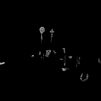CACT E-STUDIO
Loukia Alavanou was born in Athens in 1979.
How do you compile a lapsus linguae?
Her practice usually involves video-installations and animation. She often appropriates original images from popular Hollywood films, TV series, cartoons and fairytales. She uniquely combines harshness with tenderness, urged from an inner power of criticism and deconstruction that leads to the visual condensation of apparently dissimilar components. She subjects her material to distortion by cutting off limbs, wiping out faces, and allowing heterogeneous, fearsome and violent creatures to invade and occupy the screen, in order to invent an attractive but also monstrous audiovisual spectacle. Fragmentation, ironic juxtaposition, erasing and replacing are some of the techniques she uses to process her material. Thus, she manages to reverse and even undermine the given pleasure related to popular entertainment spectacles.
Her work actually constitutes an ongoing research on the methods used by the mechanisms of visual pleasure, a constant questioning of the way the mass culture representations are trying to control gendered subjectivity and sexuality. It talks about the suppressed impulses, fears and desires brought back to the fore disrupting thus the normality and effectiveness of adapting practices. For this reason it naturally assumes the form of automatic writing making use of the syntax of dreams, desires, slips of the tongue and regressions, while implying the “manual” processing of the images, the texture and construction procedure.
In Episodio 9791 (2010), the contrast between the sugary, nostalgic image of an overemphasized ideal female standard –produced and supported by soap operas– and the unruly, repulsive and “primitive” scenes of masked figures indulging in bloody or funeral rituals enhances the profound meaning of femininity as a masquerade in terms of a culturally produced image.
In Burial of a priest in an unknown village (2006), Leonidas Papazoglou’s photograph is skillfully portrayed in an enchanting animation; human body parts, ceremonial vessels, the coffin with the dead man along with other details become gradually autonomous and self-organized in a “profane” choreography – an allegory of time.
Loukia Alavanou’s iconic and acoustic collages, which sometimes refer to the public sphere while other times depict personal confessions, construct a bold and sharp outlook that constantly develops and achieves morphological and theoretical thoroughness avoiding the risk of becoming stereotypical.












